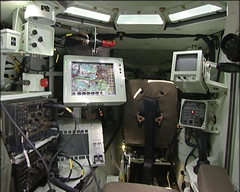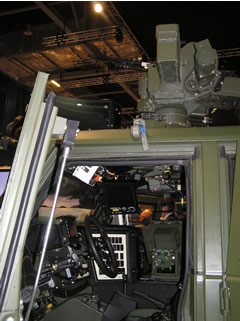At the basic level of the C4 hierarchy are the individual elements of Battle Management Systems, consisting of vehicular mounted and man-portable units, connected to higher echelons over existing Combat Net Radio (CNR) systems. When integrated into armored fighting vehicles, such as main battle tanks, armored fighting vehicles, self propelled artillery, reconnaissance vehicles and helicopters, these systems are integrated as part of existing vehicle electronics (vetronics), including fire control systems, electro-optical equipment, navigation systems, radio and intercom, countermeasures etc.
Modern vehicles are built with vetronics architecture similar to those used with aircraft avionics. Systems are comprised of local area Ethernet network, a central switch and router, main computer processor, an information server, individual displays allocated to the crew members, particularly to the commander, weapon system operator (gunner) and driver. Standard displays provided for crewmembers are used for monitoring the vehicle’s surrounding, direction of weapons and electro-optical observation gear through remote-control weapon stations etc. The commander uses a larger display, showing situational and tactical displays on digital maps. In some applications, displays can be remotely dismounted from their position for ease of operation.
 Modern AFVs are equipped wit a “glass cockpit” similar to those used in helicopters. Displays are used to augment the driver’s vision blocks, offering safe driving at night and in adverse weather conditions; other displays monitor the vehicle status, system’s health monitoring and diagnostics, emergency procedures, driving directions and display of an external out-of-vehicle view of a thermal sensor over a “virtual window” for night driving.
Modern AFVs are equipped wit a “glass cockpit” similar to those used in helicopters. Displays are used to augment the driver’s vision blocks, offering safe driving at night and in adverse weather conditions; other displays monitor the vehicle status, system’s health monitoring and diagnostics, emergency procedures, driving directions and display of an external out-of-vehicle view of a thermal sensor over a “virtual window” for night driving.
Peripheral views can be provided by multiple video cameras, situational picture of potential threats can be generated by fusing alerts from Cemical Biological Radiological Nuclear (CBRN) sensors, laser warning sensors and triggering on-board countermeasures, including fully integrated remotely controlled operation of the weapon system. Vetronics systems can link with onboard sensors, to show systems status, generate reports to local or higher levels of command.
An important feature of vehicle vetronics is the recording and simulation capability. When supported by virtual training simulators, combat vehicles become powerful training systems, where troops can take part in simulated training or perform live exercises challenged by virtual friendly and hostile entities, realistically presented over the vehicles’ sensors and systems. Real operations as well as training activities are recorded on board, for debriefing and analysis.

Communications devices include radio interface units controlling the radios, as well as digital wireless communications radio, facilitating local area wireless LAN connectivity between on-board or dismounted crew members, and neighboring vehicles. Connectivity to the Battalion level BMS network is established over CNR communications radios, which are already supporting data transfer rates of 64 Kbps. Command vehicles (Command tanks, APCs etc) can also be equipped with data radio, providing increased capacity for the user, as well as supporting functions of communications gateways and routing nodes for the entire network.
Open architecture and commercial protocols are commonly used to flexibly adapt to changes and technological development. Standards such as IEEE 802.11E wireless LAN, Voice over IP (VOIP) and CANBUS, to interface with the vehicle’s automotive system are commonly used.
This feature continues to cover the following topics:
- Tactical C4 Networking Challenges
- Building Blocks of C4 Systems
- Vehicular C4 Applications
- C4 for the Battalion Level
- Situation Assessment Tools For Dismounted Leaders
- Brigade’s Tactical Operations Center
- Common Operation Picture (COP)
- The Modern Command post
- C4 Networking Architecture
- Mission planning Tools



















